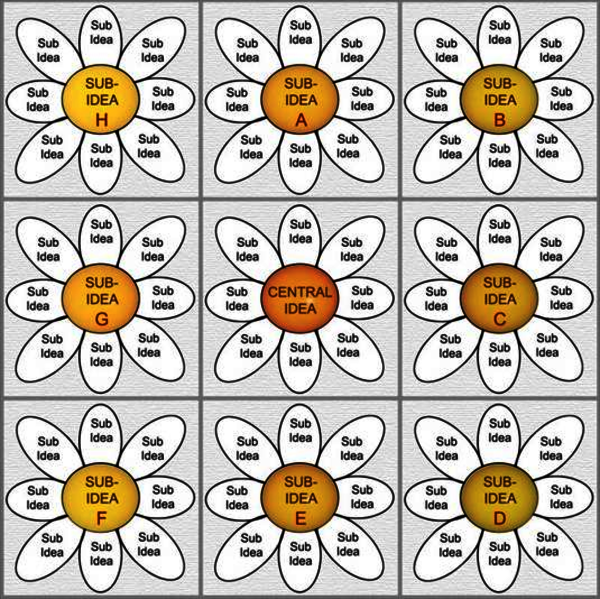Lotus Blossom Technique
The Lotus Blossom technique is designed for groups and is used to provide a more in-depth look at various solutions to problems. It begins with a central core idea surrounded by eight empty boxes or circles. Using brainstorming, eight additional ideas (solutions or issues) are written in these boxes.
Organisation
-
Duration
Medium (about 30-60 minutes)
-
Complexity
Medium
-
Group size
2 to 30 persons
This activity is not suitable online.
Description Long
The Lotus Blossom Technique or the My technique was originally developed in Japan by Yasuo Matsumura, director of the Clover Management Research. The aim of this method is to find the root causes of the problem/issue in resemblance of peeling of the petals of the lotus blossom. This technique allows you to track whole systems of interacting elements and can also be used in scenario planning and forecasting strategic scenarios.
In the Lotus Blossom, ideas evolve into other ideas and applications. Because the components of the technique are dynamic, the ideas seem to flow outward with a conceptual momentum all their own. Ideas and thoughts are not merely isolated acts and parts floating around in your mind. Unless you look at a whole system and all of its components, you may miss the key relationships and how they interact.
The process starts by defining a central subject and expanding it into themes and sub-themes, each with separate entry points. In Lotus Blossom, the petals around the core of the blossom are figuratively "peeled back" one at a time, revealing a key component or theme. This approach is pursued in ever-widening circles until the subject or opportunity is comprehensively explored. The cluster of themes and surrounding ideas and applications, which are developed in one way or another, provide several different alternative possibilities.
Illustration

Execution
- The facilitator works with the group to articulate and document the central idea or concept to be explored. This is written, usually on a large flip-chart paper for the entire group to see.
- The group 'brainstorms' up to eight significant characteristics or attributes of the topic under discussion. These are 'sub-ideas' which are to be explored later. This original diagram becomes the original 'Lotus Blossom' diagram. Each of the sub-ideas are 'seeds' for more Lotus Blossoms.
- Each sub-idea seed becomes the central idea for a new Lotus Blossom diagram. This process is repeated for each of the original sub-ideas.
- Once all the Lotus Blossom diagrams have been created, they can be used as an agenda and topics for further discussions or analysis.
- Create a template on a computer or draw a Lotus Blossom diagram on a wall chart.
- If Ideas have been collected in a previous step, they can be collected on Post It's and stuck onto the template to be further developed.
Hints from experience
The optimal number of themes for a manageable diagram is between six and eight. If you have more than eight, make additional diagrams. Ask questions like: What are my specific objectives? What are the constants in my problem? What are the dimensions of my problem?
Prioritize ideas, solutions, options and other results by using colored markers or applying colored dots for next steps.
Tools list
- duct tape
- Sticky dots
- Paper, big, flipchart
- Sticky notes
- Writing utensils, pen, pencil
References
Higgins, J. M. (1996). Innovate or evaporate: creative techniques for strategists. Long Range Planning, 29(3), 370-380.
Sefertzi, E. (2000). INNOREGIO: dissemination of innovation and knowledge management techniques. Report produced for the EC funded project. Retrieved 29 October 2015, from, http://www.urenio.org/tools/en/creativity.pdf
Diegm.uniud.it,. (2015). Lotus Blossom Technique. Retrieved 30 October 2015, from http://www.diegm.uniud.it/create/Handbook/techniques/List/Lotus.php
VanGundy, A. (2005). 101 activities for teaching creativity and problem solving. San Francisco: Pfeiffer, A Wiley Imprint.
Sloane, P. (2006). The leader's guide to lateral thinking skills. London: Kogan Page.
Jsalvis.com,. Facilitation Technique Number 8: Lotus Blossom Technique. Retrieved 30 October 2015, from http://jsalvis.com/ReadingRoom/Business-and-Behavior/Facilitation/fac08a.htm
Lillicrap, D. (2011). The Lotus Blossom Technique. 5by5design.com. Retrieved 30 October 2015, from http://www.5by5design.com/blog/design-practice/lotus-blossom-technique/
Mahal, A. (2015). Facilitator's and Trainer's Toolkit: Engage and Energize Participants for Success in Meetings, Classes, and Workshops. Technics Publications.